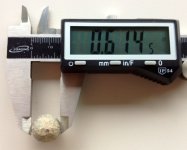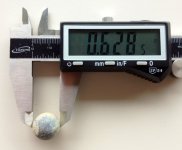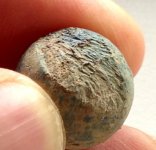You are using an out of date browser. It may not display this or other websites correctly.
You should upgrade or use an alternative browser.
You should upgrade or use an alternative browser.
Musket balls - what era?
- Thread starter ATDigger
- Start date
Digger70pa
Forum Supporter
Looks like a mouse was chewing on it. Looks old.
Donneybrook
Elite Member
- Joined
- Jun 24, 2013
- Messages
- 4,340
Keep searching! Looks like a .69 caliber, anyone agree? Good luck man! 

Donneybrook
Elite Member
- Joined
- Jun 24, 2013
- Messages
- 4,340
Definitely War of 1812 as long as you find other artifacts. Keep me
Posted!
Posted!
copper head
Elite Member
- Joined
- May 13, 2010
- Messages
- 1,337
Keep searching! Looks like a .69 caliber, anyone agree? Good luck man!
they look more around .62 and .63 caliber from the micrometer
ATDigger
Senior Member
Not a whole lot of artifacts from that era, but then again, I rarely dig iron targets so I'm probably missing a bunch. I have found some early buttons including the LA button. I've also found a ton of "lead drippings" which, until now, I assumed were from soldering copper gutters or similar. Now I think it was probably from casting musket balls! 

Donneybrook
Elite Member
- Joined
- Jun 24, 2013
- Messages
- 4,340
they look more around .62 and .63 caliber from the micrometer
Ya know, I thought so, but I didn't know if they made 61-62 caliber round balls so I went with 69.
Donneybrook
Elite Member
- Joined
- Jun 24, 2013
- Messages
- 4,340
Yes, you definitely need to look for more artifacts, if u find more artifacts from the war then you'll know for sure
gunsil
Elite Member
Regarding ID of musket balls, nothing to hang your hat on (date, country, etc).
Better not to spend too much time worrying. ID is nearly impossible.
yando is quite right. Lead gets a coating of lead oxide (the white stuff on old lead). This oxide forms a barrier against further oxidation and the oxide no longer grows. In different soil conditions it may grow slower or faster, but at some point it seals the lead against further corrosion. Hence a ball that has been buried for 100 years will look the same as one that was in the ground for 200 years. Sometimes they can reach the level of no more oxide growth in 50-75 years. All military firearms sooner or later become "army surplus" and were used for hunting well after their military use and balls were used in pistols, muskets, rifles, and shotguns.
Donneybrook
Elite Member
- Joined
- Jun 24, 2013
- Messages
- 4,340
I found some musket balls and took them to the coin store (he hunts artifacts too) and he imediately said they were from the second seminole war. You know what! He was right! Thus, untill proven otherwise, say they are from the war of 1812! Finding more artifacts will confirm or upset this theory. Good luck man.
ATDigger
Senior Member
Thanks guys!
laserfeller
New Member
- Joined
- Feb 28, 2010
- Messages
- 21
The musket balls pictured above are the size used in 69cal muskets, such as the French Charleyville, used by American forces during the Revolutionary War and War of 1812. Musket balls that measured 69cal were used in the British 75cal Brown Bess musket. The marks on your musket ball could have been made by medical tongs used to extract the ball from a wound.
Here is a good article about musket balls recovered from the Revolutionary War battlefield at Monmouth NJ.
http://www.southerncampaign.org/sample-page/
Scroll down and click on "Vol. 2 No. 1" to download the pdf article.
Here is a good article about musket balls recovered from the Revolutionary War battlefield at Monmouth NJ.
http://www.southerncampaign.org/sample-page/
Scroll down and click on "Vol. 2 No. 1" to download the pdf article.
ATDigger
Senior Member
Wow - Great info and great article Laser! Thanks!! 






